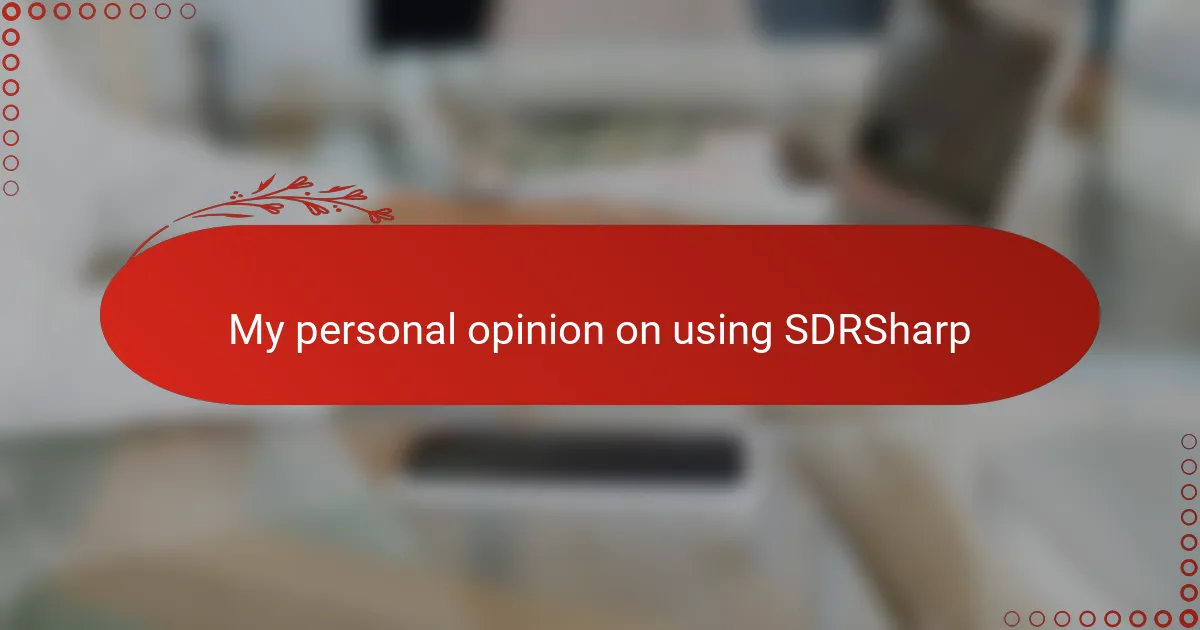Key takeaways
- Radio broadcasting combines technology and creativity, providing a unique sense of immediacy and community that remains relevant despite the rise of streaming and podcasts.
- SDRSharp offers an accessible and versatile platform for exploring the radio spectrum, allowing users to listen to various frequencies and decode digital signals easily.
- Effective use of SDRSharp involves optimizing settings like gain and bandwidth, enhancing clarity and listening experience through visualization of the frequency spectrum.
- Familiarizing with plugins and customizing the interface can significantly enhance the functionality and user experience of SDRSharp, transforming simple listening into deeper explorations.
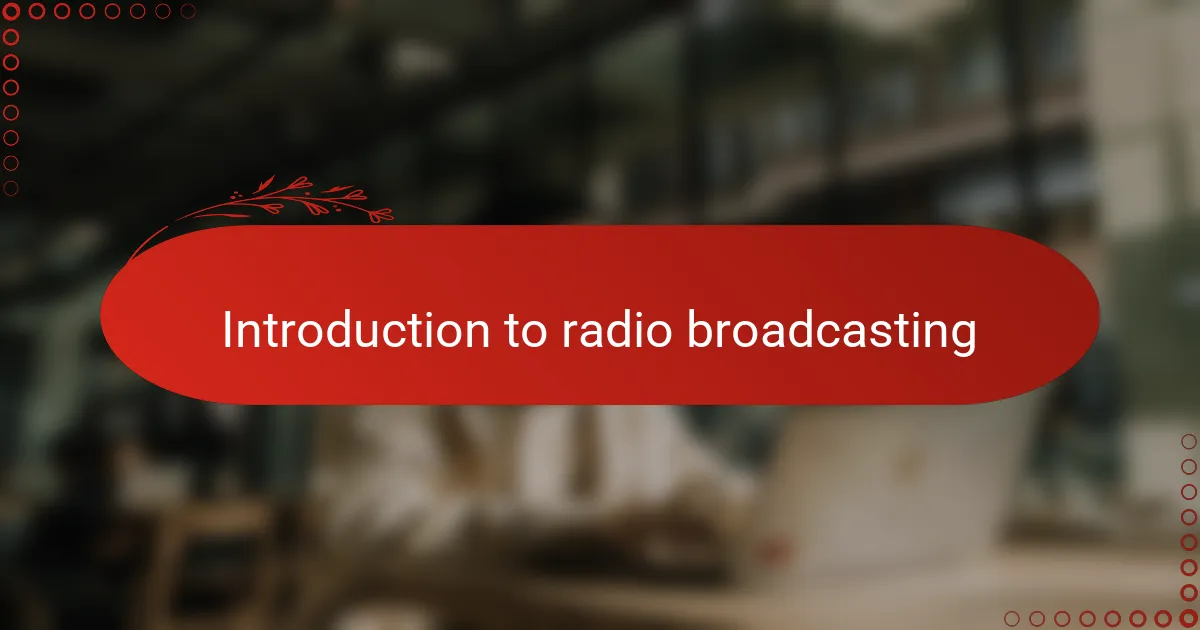
Introduction to radio broadcasting
Radio broadcasting has always fascinated me because it’s like an invisible thread connecting voices and stories across distances. Have you ever thought about how a simple radio signal can carry so much emotion and information straight into your living room? It’s a powerful medium that combines technology and creativity in a way few other platforms do.
What strikes me most is the way radio blends the technical with the personal. Behind every broadcast, there’s a mix of engineering precision and human expression. This balance is what makes radio feel alive, and as someone who’s tinkered with radio equipment, I can tell you it’s both challenging and rewarding.
Sometimes, I pause and wonder why radio broadcasting still matters in an era dominated by streaming and podcasts. Maybe it’s because radio has a sense of immediacy and community that others can’t quite match. This unique quality is something I truly appreciate and why I keep coming back to explore its depths.
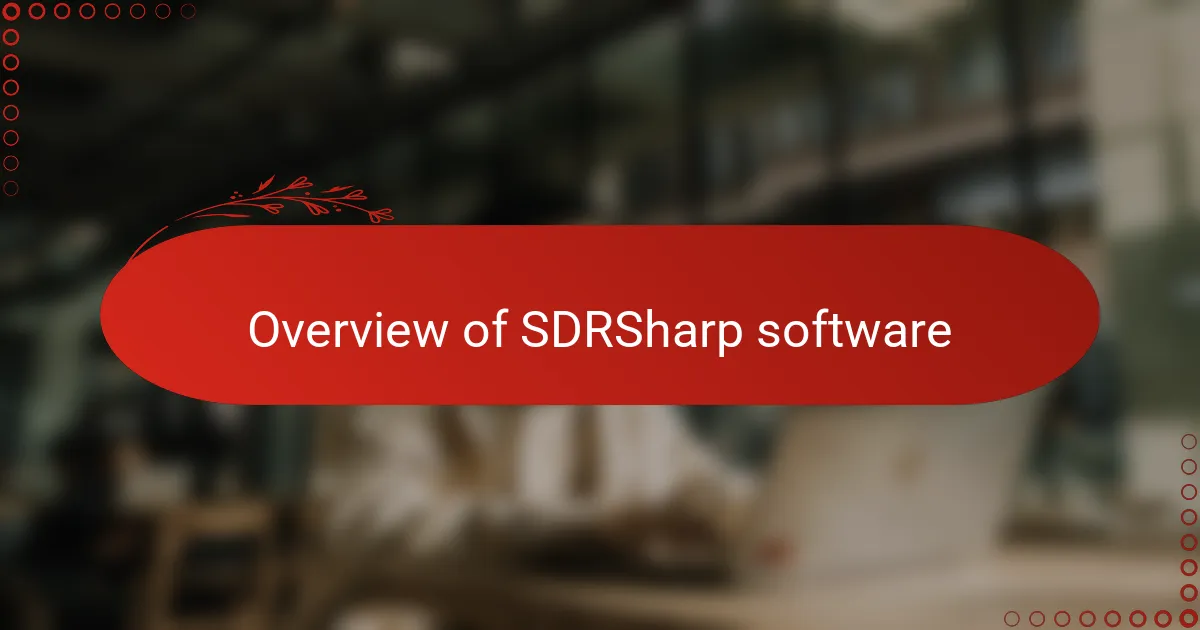
Overview of SDRSharp software
When I first came across SDRSharp, or SDR# as many call it, I was impressed by how accessible software-defined radio became through this tool. It’s surprisingly user-friendly, especially for someone like me who’s more intrigued by what’s coming through the airwaves than by complex setups. Have you ever experienced that moment when you suddenly realize a single program can unlock so many frequencies and possibilities?
What I find truly engaging about SDRSharp is its versatility. From listening to local FM stations to decoding digital signals, it feels like having a whole radio lab on your computer. My first time tuning into a distant shortwave broadcast using SDRSharp was thrilling—it made me appreciate just how rich and varied the radio spectrum really is.
The software’s straightforward interface also makes it a great gateway for beginners and hobbyists. I remember hesitating at the start, worried it might be too technical, but SDRSharp’s clear controls and visual feedback quickly eased those concerns. Isn’t it wonderful when technology invites you in rather than pushing you away?
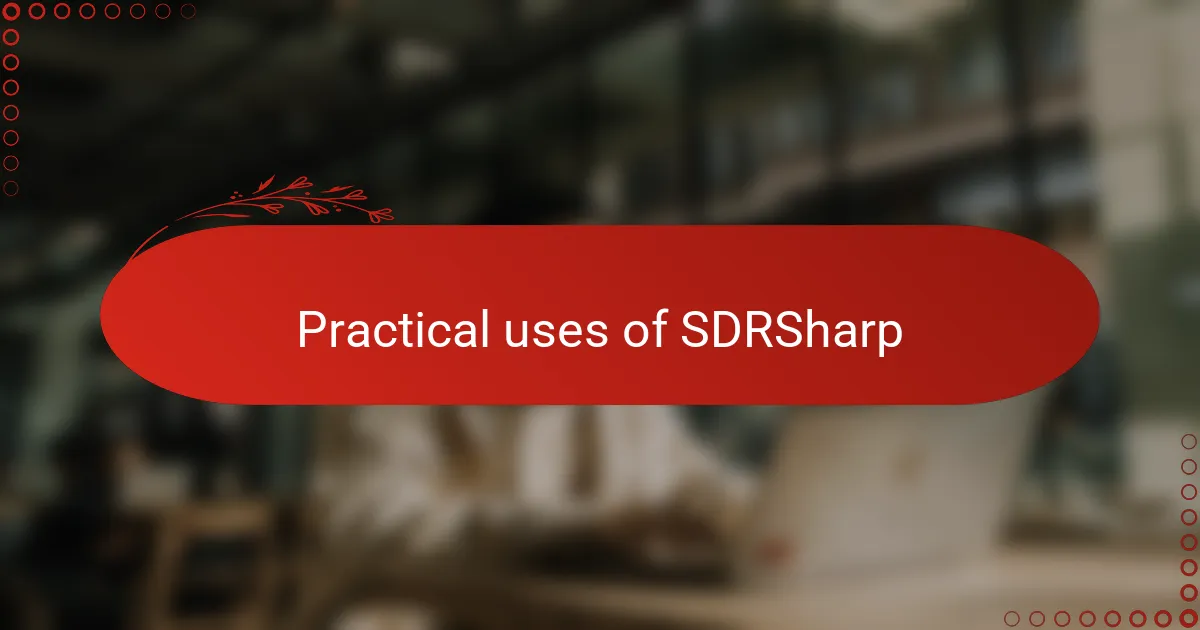
Practical uses of SDRSharp
One of the practical uses of SDRSharp that I find particularly rewarding is its ability to scan and monitor a wide range of frequencies effortlessly. It’s like having a front-row seat to the invisible world of radio signals around you. I remember once stumbling upon a rare maritime transmission late at night—a moment that made me realize how much you can discover with this tool.
Another use I’ve explored is decoding digital signals, such as weather satellite images or pager messages. Honestly, it felt a bit like being a detective, piecing together bits of data that are usually hidden from the casual listener. Have you ever experienced that rush of turning raw signals into usable information? SDRSharp makes that process surprisingly accessible and engaging.
It’s also handy for experimenting with various modulation types. I’ve spent hours just playing around with AM, FM, and even some digital modes, learning how each affects the quality and clarity of transmissions. This hands-on experience reinforces my belief that SDRSharp isn’t just software; it’s an interactive classroom for anyone curious about radio technology.
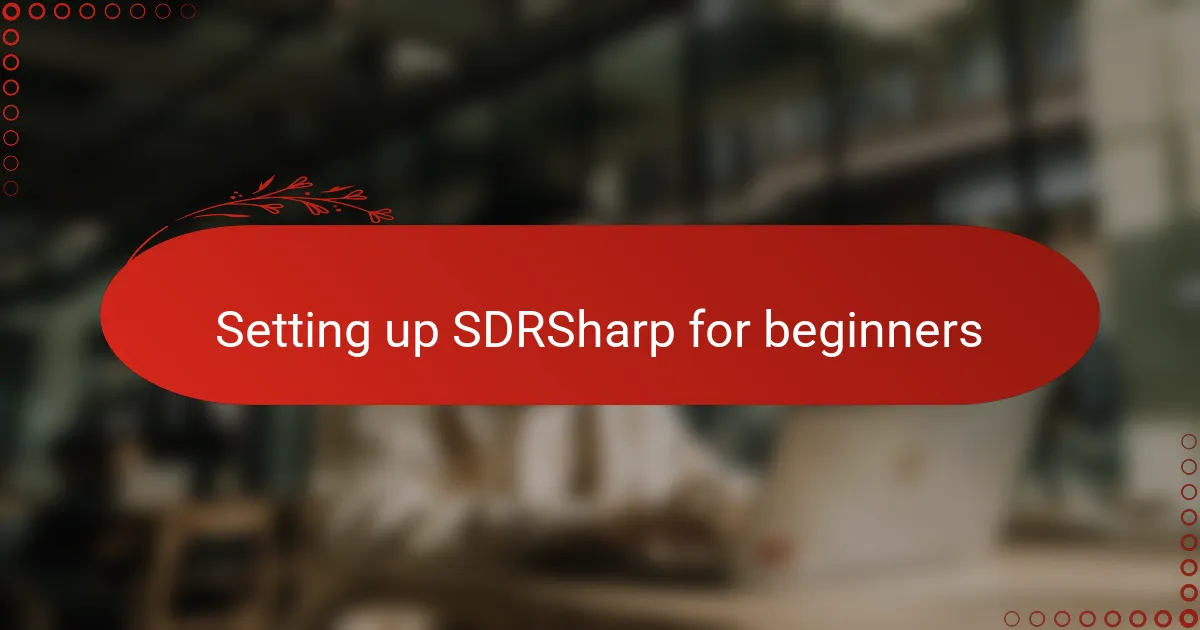
Setting up SDRSharp for beginners
Getting started with SDRSharp was less intimidating than I expected, mainly because the installation process guided me step-by-step. I remember plugging in my SDR dongle and watching the software instantly recognize it—there was this satisfying “click” of everything falling into place. Don’t you love it when technology just works without a fuss?
Configuring the basics like selecting the correct device and setting the sampling rate felt straightforward, yet I kept wondering how tweaking these settings would change what I could hear. Playing around with the gain control was surprisingly fun—I found that small adjustments made a big difference in signal clarity, which made me realize how much nuance there is in radio reception.
The real breakthrough for me was exploring the panadapter display, showing the spectrum live and allowing me to click directly on frequencies of interest. That visual feedback made the whole experience more tangible, almost like watching radio waves dance across the screen. Have you tried this feature yet? It’s a simple step but one that made me feel instantly connected to the invisible world around me.
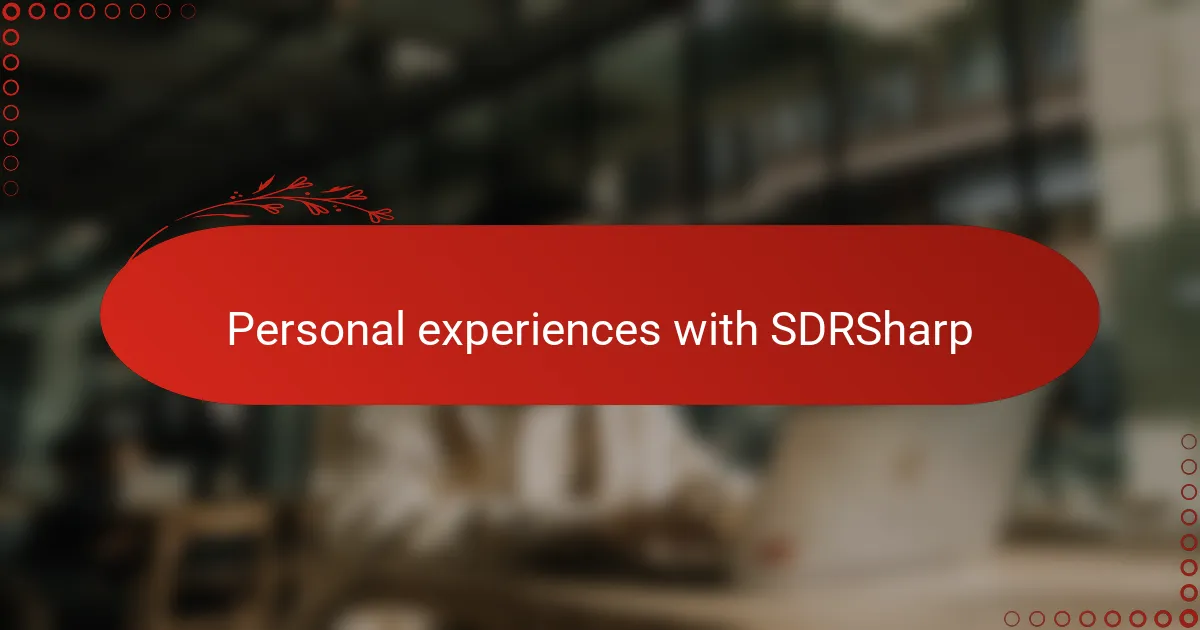
Personal experiences with SDRSharp
Using SDRSharp has been a game-changer in my radio exploration journey. I still recall the excitement of catching my first distant HF station late at night—there was a rush of discovery that reminded me why I love radio so much. Have you ever felt that thrill when a faraway voice suddenly comes alive through your speakers?
Sometimes, I’ve found myself lost in the software’s depth, tweaking settings to pull in clearer signals or experimenting with different bandwidths just to see what happens. It’s surprisingly satisfying to know that a few clicks can transform static into crisp audio. Doesn’t it make you appreciate the blend of science and art behind radio waves?
One quirky moment I can’t forget was accidentally intercepting a local emergency channel during a routine scan. It was unexpected and a bit eerie, but it underscored how connected this technology makes you feel to your environment. Have you ever had one of those “wow” moments where radio becomes more than just sound? That’s SDRSharp for me—always full of surprises.
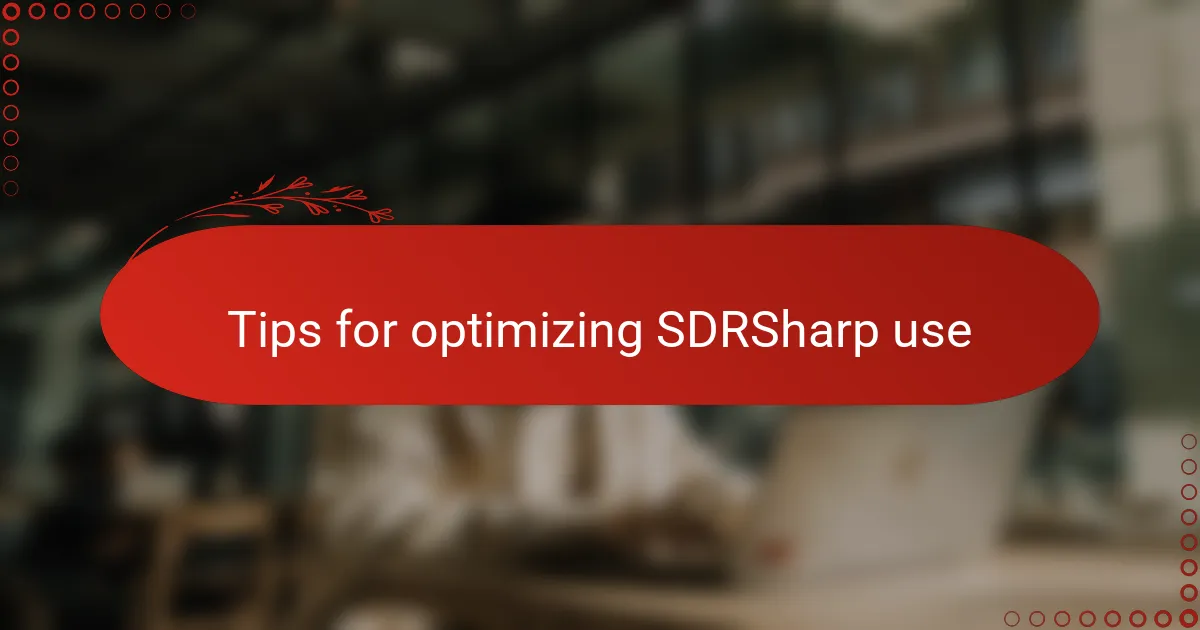
Tips for optimizing SDRSharp use
One tip I’ve found invaluable in optimizing SDRSharp is carefully adjusting the gain settings. It took me a while to realize that too much gain just introduces noise, while too little leaves signals faint and hard to make out. Have you played with the gain slider enough to find that sweet spot? It’s almost like tuning an instrument—you need just the right touch to get the best sound.
Another thing I recommend is making use of the bandwidth control. I remember initially ignoring this feature, but once I started narrowing or widening the bandwidth, the clarity of certain broadcasts improved dramatically. It’s fascinating how a subtle tweak can separate the signal from the noise, bringing distant stations more clearly into focus.
Finally, don’t overlook the power of the frequency spectrum display—the panadapter. I often find myself visually scanning the spectrum for interesting signals, like tracking a spike that might indicate a nearby transmitter. That real-time feedback turned listening from a passive activity into an interactive hunt. Have you tried chasing those fleeting signals on the waterfall yet? It’s a small change that makes a big difference in engagement.

Recommendations for SDRSharp users
When starting out with SDRSharp, I strongly recommend familiarizing yourself with the plugin ecosystem. Plugins can dramatically expand the software’s capabilities, letting you decode everything from digital voice formats to weather satellite images. Have you explored plugins yet? Adding just a couple changed how I use SDRSharp entirely, turning simple listening sessions into deeper explorations.
Another tip I can’t stress enough is to regularly calibrate your SDR device within SDRSharp. At first, I overlooked this, thinking the default settings were good enough—but recalibration made a noticeable difference in signal accuracy and stability. It’s a quick process that saved me from chasing phantom signals and helped me trust what I was hearing.
Finally, take advantage of SDRSharp’s customizable interface. I remember feeling overwhelmed by all the controls, but slowly tweaking the layout to fit my workflow helped me focus on what mattered most. Isn’t it nice when a tool can adapt to you rather than forcing you into its mold? This flexibility not only makes usage smoother but also keeps the experience continuously engaging.
